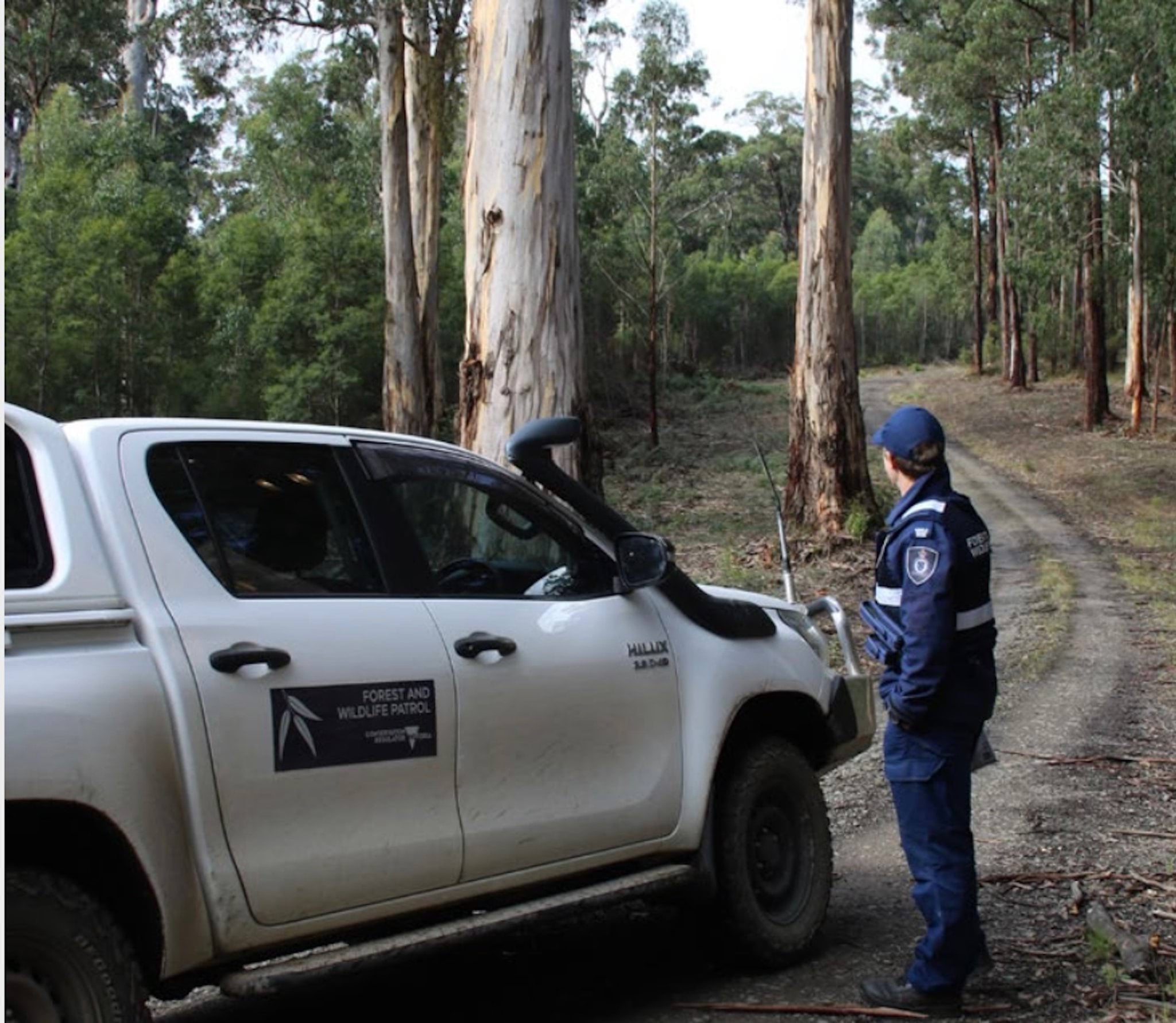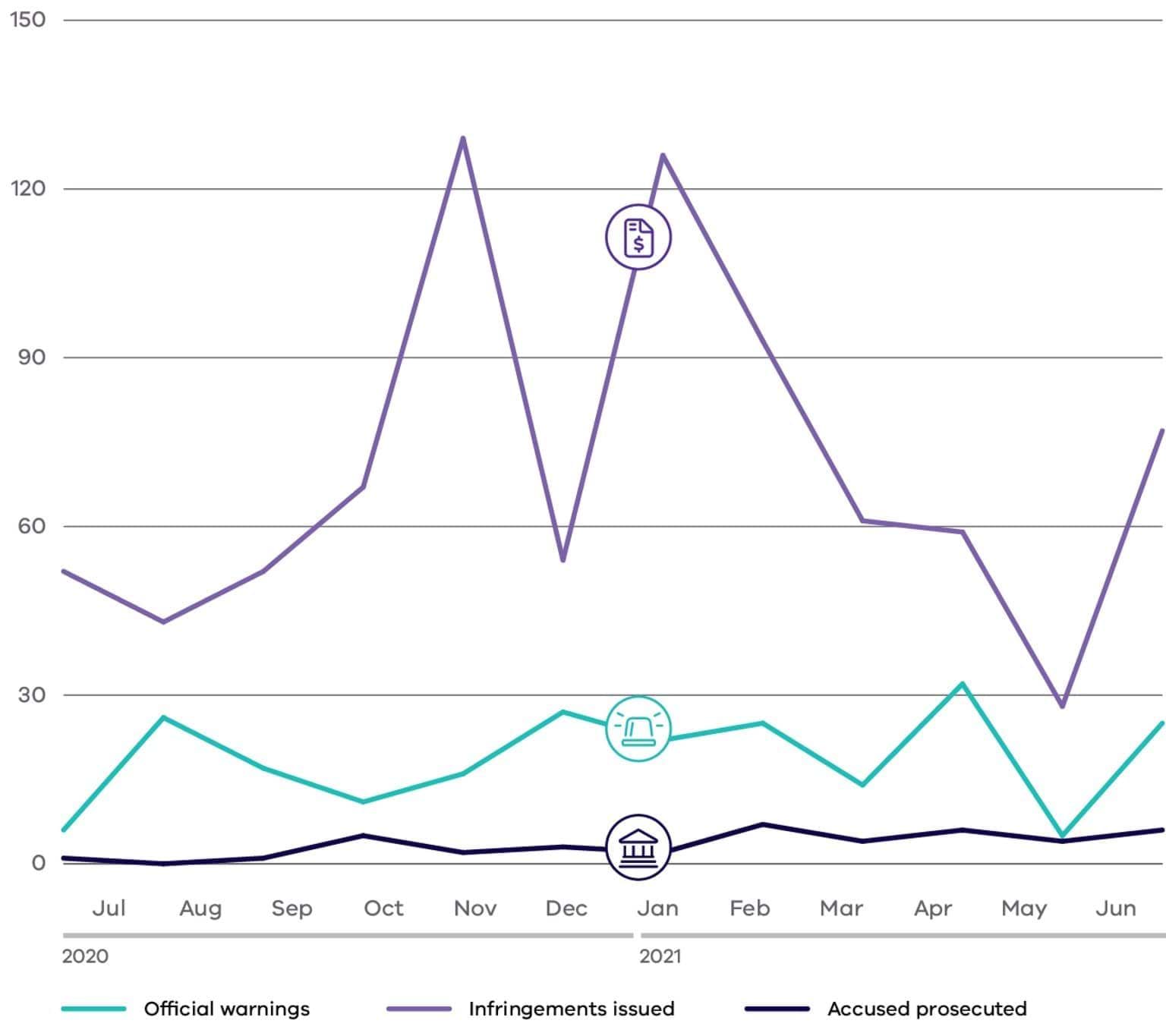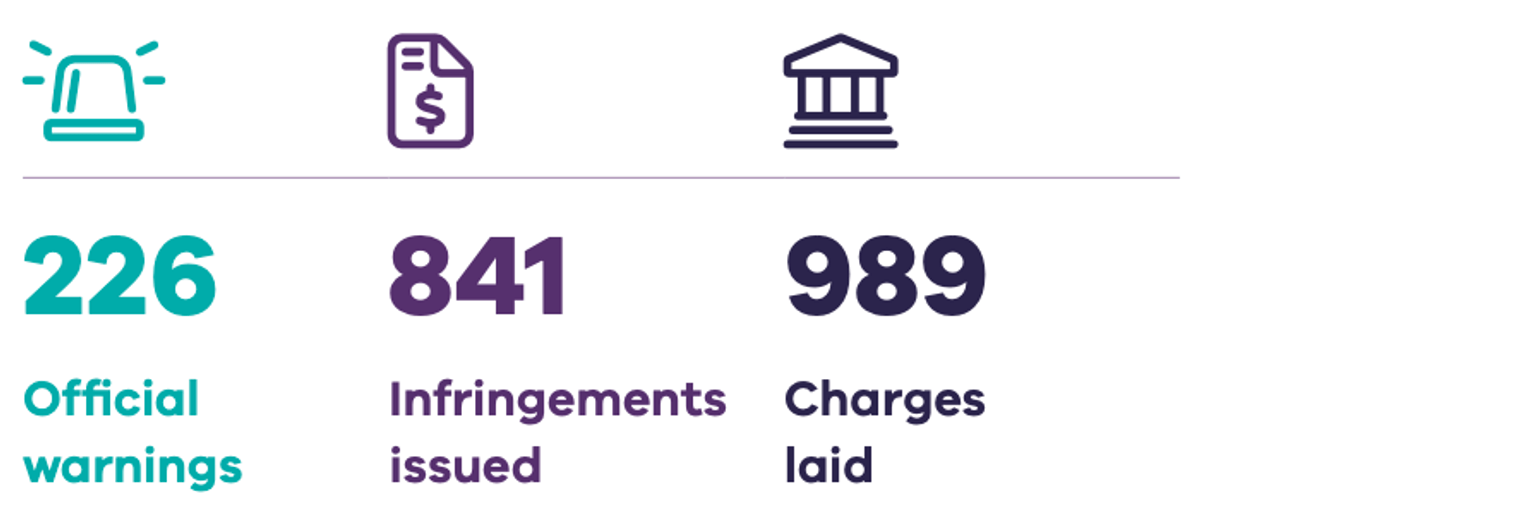In 2020–21 we delivered significant outcomes to support our regulatory priorities. In recognition of the significant regulatory risk relating to the keep, trade and management of native wildlife, an additional regulatory priority relating to wildlife was included for 2020–21.
Continued focus was provided on each of the regulatory priorities, building off the achievements made in our first year of operation.
Illegal campfires
After a devastating 2019–20 bushfire season, 2020–21 saw few fire events. The Conservation Regulator maintained a strong focus on the key risk of bushfires being ignited by illegal campfires, by establishing this as a key priority under Operation Guardian (see case study below).
Around 10 per cent of bushfires are caused by campfire negligence, and the Conservation Regulator has a major focus on educating the public about how to be campfire safe and identifying non-compliance to protect the Victorian community from the devastating impacts of bushfires.
Authorised Officers detected more than 800 unattended or abandoned campfires from July 2020 to June 2021. In 2020–21 there were 18 prosecution charges laid relating to illegal campfires including 7 on days of Total Fire Ban.
We continued our campfire safety education campaign in the media, on social media and through our increased number of Authorised Officers on the ground, particularly during the warmer months.
Illegal take of firewood
The illegal take of firewood continues to be a major issue in Victoria. There are two firewood collection seasons each year where wood can legally be taken from designated areas on public land.
Unfortunately, not everyone follows the rules of where, when and what wood can be collected. The Conservation Regulator works to ensure compliance with firewood collection rules.
In 2020–21 there were 51 illegal firewood prosecution charges laid. Our multi-agency firewood operation, Operation Hollows, continued into the 2021 season with a renewed focus on working with other land managers, as well as a regional approach in dealing with key offenders and hotspots for firewood theft.
We worked closely on this operation with partner agencies Forest Fire Management Victoria and Parks Victoria. We also developed a regulatory strategy for illegal firewood which will operate until 2023 to help us efficiently and effectively regulate illegal firewood removal from public land.
Regulating native timber harvesting
The Conservation Regulator is responsible for monitoring compliance and enforcing the law for native timber harvesting in state forests.
There are a range of programs and activities that the Conservation Regulator delivers to fulfill this responsibility, and these are further detailed in Regulating timber harvesting.
Operation Guardian
Through 2020–21, Authorised Officers across the state have been proactively patrolling state forests identifying non-compliance and informing members of the community about the rules in state forests.
This operation supported directions from Victoria’s Chief Health Officer around COVID-19 restrictions, including physical distancing and group gatherings. It aimed to maximise compliance and reduce potential transmission of the virus.
It also integrated patrolling activities across our regulatory priorities of illegal campfires, illegal firewood, and the illegal use of public land, delivering strong results.
In 2020–21, a total of 818 patrols were conducted across the public land estate focusing on areas of high visitation and environmental risk.
Regulating the use, keeping, trade, treatment and control of wildlife
This new regulatory priority aimed to raise awareness about the protection of Victoria’s wildlife.
The Conservation Regulator plays an important role in protecting Victoria’s wildlife, by identifying, investigating and prosecuting those responsible for wildlife crimes.
This year we released a new regulatory guide for minimising the impacts to koalas in blue gum plantations for plantation owners and managers. It also describes how the Conservation Regulator will oversee authorisations, compliance and enforcement.
We have continued to work closely with Crime Stoppers Victoria in 2020–21, encouraging the public to report suspicious wildlife behaviour through this anonymous channel.
Sadly, wildlife cruelty is still an issue our Forest and Wildlife Officers encounter across the state.
In 2020–21 there were 905 prosecution charges laid relating to wildlife.
We work closely with partner law enforcement agencies, to undertake investigations targeting wildlife crimes and use all the tools at our disposal to stop these crimes – from surveillance technology and search warrants to data extraction and forensic techniques and equipment.
Taking action on wildlife crime
Each year, the Conservation Regulator assesses and investigates hundreds of reports of wildlife crime. These includes harm to individual wildlife, or more systematic activities where harm is brought against a large number of animals.
Since 2019, the Conservation Regulator has been working with Forest Fire Management Victoria, Victoria Police and Agriculture Victoria to investigate a number of deceased wedge-tailed eagles found in the Violet Town area.
In December 2020, a Violet Town individual was charged over the unlawful possession of more than 140 protected native bird carcasses, 128 of them wedge-tailed eagles, which were found across paddocks north of Violet Town.
The individual is facing 291 charges under the Wildlife Act 1975 and Prevention of Cruelty to Animals Act 1986, including the poisoning of wedge-tailed eagles.
The Conservation Regulator is committed to combating wildlife crime and protecting our iconic species.
Permits and licencing
The keeping of most wildlife requires a licence or permit which the Conservation Regulator is responsible for issuing.
We are also responsible for assessing and issuing Authority to Control Wildlife permits to landowners having ongoing issues with native wildlife including damage to buildings, pastures or crops.
Since being established in 2019 we have worked to improve the Authority to Control Wildlife system by improving: guidance for applicants; assessment methods for our staff; and guidance on when external expert advice should be sought.
Each year the number of permits issued varies, largely due to environmental conditions. In 2020, we experienced a significant increase in applications for wildlife licences and permits during each of Victoria’s lockdown periods. At their peak, there was a 50 per cent rise in applications.
In 2020–21 more than:
- 3,400 private wildlife licence applications were processed which resulted in over 2,600 licences issued
- 70 new commercial wildlife applications were processed
- 1,400 import and export permits were processed.
Our role is also to support licence and permit holders in understanding their obligations and we monitor compliance with licence and permit conditions. We do this by providing supporting guidance and information at point of application and renewal of licences and permits, and also field hundreds of enquiries each year that come via email, or through the Customer Call Centre.
Monitoring compliance is also essential. Across the state, our regulatory operations teams conducted hundreds of compliance checks of private and commercial wildlife licences and permits.
Protecting Victoria’s biosecurity and agriculture
Taking, keeping, and trading unlawfully obtained wildlife are serious offences which can have a huge impact on biosecurity.
This is why the Conservation Regulator plays a key role in wildlife licencing and permissions.
In November 2020, a three-metre long Albino Burmese Python was seized from a Ballarat home after a search warrant was conducted by Conservation Regulator Authorised Officers, Agriculture Victoria and Victoria Police.
It is illegal to privately own a Burmese Python in Victoria due to the threat they pose to the state’s biosecurity and agriculture. Due to their size, these pythons also pose a risk to people and domestic pets in the event the animal escapes or is released.
The animal was euthanised and the investigation is ongoing.
Illegal vehicle use on public land
Off-road driving in forests, parks and reserves can cause erosion, damage native vegetation and destroy wildlife habitat. Patrols to stop and deter this illegal activity were conducted throughout the year.
In 2020, off-road motorcycle sales jumped more than 30 per cent compared to the previous year. This increase in sales suggests that there are more people out in our state forests, some of whom may not always be complying with the law.
Authorised Officers observed thousands of riders and drivers in forests, parks and reserves.
In 2020–21 there were seven prosecution charges made relating to off-road vehicle use on public land.
This was also part of Operation Guardian patrols and Authorised Officers also reported to Victoria Police unlicenced drivers or riders, and unregistered vehicles.
Figure 2 provides a month-by-month breakdown of the number of warnings and infringements issued, and number of accused prosecuted.
The number of prosecutions being heard declined in 2020–21 due to COVID-19, and the number of infringements and warnings increased compared to 2019–20 levels due to increased patrolling of the public land estate.
Updated







